I’m pretty convinced that tarot card reading is just an organized framework for letting your intuition loose (today, anyway; talk to me some other time and I’m convinced that it’s all woo-woo). And there’s a lot about it as an experience that’s appealing to me as a woman. I can speak with authority, because I can read something that the person sitting across from me can’t. I can have a level of intimacy with someone I don’t know very well and learn a great deal about her while being a part of her working out her own stuff. And because having your cards read is usually a weird and infrequent experience for that person, I think you feel like you’ve kind of arrived in a liminal space, not quite real life, where all that other stuff is set aside and it’s just two people doing this strange thing.
In other words, I think it’s a weird thing, but I don’t think it’s exactly supernatural. I think it’s just that we pick up on a lot of information from other people that we make use of without exactly realizing it and this, like I said, just gives you a framework for letting all that information come at you while you make meaning out of it intentionally instead of passively, if that makes sense.
I use my own variation on the Celtic Cross spread, which a lot of folks use, and I have a nice 21 card spread I like a lot,  which looks very similar to the one used by the card reader in the painting here.
which looks very similar to the one used by the card reader in the painting here.
But I want to talk about not just this painting, but the whole series of paintings of this woman that Harry Herman Roseland did, which you can view over at Mary K. Greer’s excellent tarot blog. Because when I saw them all in a group like that, stuff started jumping out at me that I don’t think I’d have picked up on if I’d just been looking at one painting.
Because, I think, if you just look at one painting, it’s easy enough to get caught up in the intimacy of the reader and the person being read for. Look at how they both lean over the cards, their heads curved in towards each other. The African-American woman is the one with the power, with the literacy to read the cards in a way the white woman can’t. It seems like the Black woman has control of the situation because they seem to be in her house, on her turf.
But when you see them all together like that, other things start to jump out, like the disparity in their social standing. The white women all have on very lovely clothes and the Black woman is dressed in work clothes. Look at how in every single painting, her knitting is close by, in one case, we can see it on her lap. These white women have literally interrupted her work. (Though, I think Greer is right in the comments that we can’t overlook the symbolism of having a woman who works with yarn reading people’s fortunes.) Also, look how many of them keep their hats on, as if, for them, they are still in a potentially public space. And the parasols! Look at how they point towards the reader in so many pictures, reaffirming that no matter what kind of intimacy we might think we’re seeing, there are some strong and potentially violent barriers between them.
I also think it’s interesting that the white women are almost always higher up in the picture, still literally above the reader. But it’s not as if the white women aren’t also in precarious positions. You might stop and see a fortune teller at a fair on a whim, but once you’ve taken the trouble to go to someone’s house (and I think that the fact that the white women are almost always pictured in pairs is not just indicative of it being problematic for them to be out in public alone, but also that they were doing something abnormal for them and wanted moral support), it’s usually about a level of desperation, of needing guidance or an edge in whatever.
It’s easy to imagine that these women are there inquiring about matters of the heart, or whether they will have children, but it’s easy also to loose sight of how important it was for women at that time to be able to do those things, in order to have social security. It might be weird to call it a feminist act, but I look at these paintings and I see a kind of proto-feminist act–women working together, through secret knowledge we don’t see shared with men, to make their lives a little easier to navigate.
I wonder, too, if we aren’t seeing the card reading as a way to mitigate the racial reasons the reader would not be able to present herself as telling the white women something they don’t know; they can maintain a fiction that it’s not her giving advice and passing along wisdom. She’s reading the cards. In one painting, she’s even consulting with a book. And this gives the white women a framework through which they can actually hear from a black woman and take what she says to heart.
As a reader, that’s something I’ve enjoyed, even if I couldn’t articulate it–the ability to speak with authority and be taken seriously, even when it might seem in other circumstances that I couldn’t know what I was talking about
I sometimes think that’s what appeals to me about blogging, too.